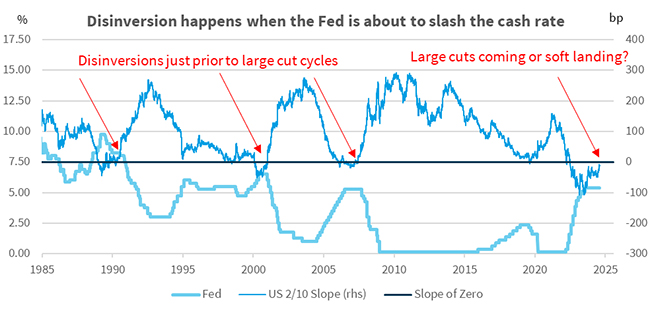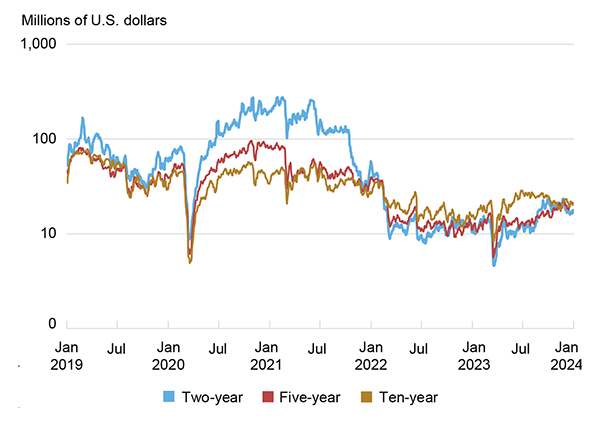by
Philip Brown, Head of Research | Aug 05, 2024
Incredible moves in pricing suggest shallow liquidity (most likely) or a just a faint risk of a serious problem. RBA will watch and wait.
The outlook for the RBA has shifted dramatically in the last week – and it’s not just the CPI. Up until the recent Australian CPI print, we thought a rate hike was more likely than not. That’s emphatically no longer true. The RBA is almost certain to leave rates on hold this afternoon. We’ve discussed the recent CPI print in detail before and, while the inflation rate is not so low as to make the RBA comfortable, it’s also not so high that the RBA is forced to raise rates. There’s just enough wriggle room for the RBA to avoid raising rates if they don’t want to. And, given some of the other things happening in the world right now, we’re pretty sure they don’t want to move rates.
US payrolls data on Friday was poor, essentially guaranteeing the Federal Reserve begins to cut rates shortly. The unemployment rate rose from 4.1% to 4.3% and there were only 114k jobs created when market had been expecting 175k. However, the market reaction has been over the top. In an astonishing move over Friday and Monday, interest rates in the US have dropped alarmingly. The US 2-year yield is now 65bp below where it was last Monday and 40bp below the level of Thursday. At the Australian close yesterday the market was pricing 110bp of rate cuts from the FOMC over the next two meetings, through this has now dropped to “only” 90bp. The excesses of multiple 50bp cuts would be a Global Financial Crisis style Fed response and seems completely out of proportion with the data. We expect the FOMC will be looking to lower rates slowly, rather than cutting rates hard and fast into stimulatory territory the way bond market pricing is suggesting.

Source: FIIG, Bloomberg
The market reaction is more wide-spread and sharper than it seems it ought to be. It’s not just bond markets moving, though. Japanese equity markets fell 6.23% yesterday while the Australian ASX was down a further 2.6% on Monday to be 5.73% below Thursday’s level – and back to levels last seen in May. If the move stops here, it’s a small washout and not particularly material in the grand scheme of things. However, we can’t know for sure the move has stopped. Monday in Asian time is before the US open, but yesterday was also a Sydney bank holiday, notably lowering liquidity in Australia. We discussed a mad rush to exit the JPY carry trade as one possible explanation of the move and the fact that the Japanese markets were strongly affected adds to the idea this is a global repositioning reflecting a new world where JPY rates are rising and US rates are falling. This exit of a carry trade has happened many times before, but seems to be hitting markets harder and faster than previously. Given the BoJ is actually raising rates (rather than just feared to) that is perhaps not a surprise, but it also suggests that global liquidity might be weaker than in the past.
We hope this lack of liquidity is temporary, but it might not be. The US Federal Reserve commented in February that Treasury market liquidity had dopped dramatically in 2020 and again in March 2023 – but in doing so also seems to be making the case that liquidity is much poorer now than it used to be.
Order Book Depth for US Treasuries – log scale

Source: US Federal Reserve
It seems odd to be discussing US Treasury liquidity in an RBA preview – that’s because it is. However, the RBA has a history of deliberately not stoking volatility at these times of increased uncertainty. In April 2023, the RBA declined to raise rates during the worst of the US banking issues around SVB, citing the elevated volatility as one reason not to move. Now, it must be remembered that the RBA went back to hiking once the situation had calmed down. While the current bout of volatility is concerning, it should calm down in coming days. But the RBA will likely want to play their small part to bring that about by playing a very straight bat this afternoon. We don’t believe the RBA will be cutting rates anywhere near as quickly as the market pricing suggests for Australia. Once the heat comes out of the US and Japanese moves and a bit more stability returns, the Australian yields should drift higher, particularly in the front-end of the curve. But against this backdrop, Australia is a slave to the global movement.
The market backdrop makes it likely the RBA will try to placate volatility. If the RBA does decide to give a more detailed view, the items to watch are any RBA discussions of the retail side of the economy and labour productivity. The retail side of the economy has been becoming stronger while the tax cuts are going to start impacting the data very soon. Labour productivity is one place that most market commentators seem to be ignoring as CPI takes centre stage, but the RBA routinely says things like “wages growth appears to have peaked but is still above the level that can be sustained given trend productivity growth.” In the May statement, the RBA was forecasting an astonishing 1.8% growth in labour productivity in the year to June 2024. Given the increase in the employment/population ratio and the increase in recent job mobility, we’re not sure the labour productivity forecast can be met. Both of these factors, retail strength and labour productivity, are key to assessing the medium-term outlook for CPI, which is why we’re keen to hear the RBA’s view on them.